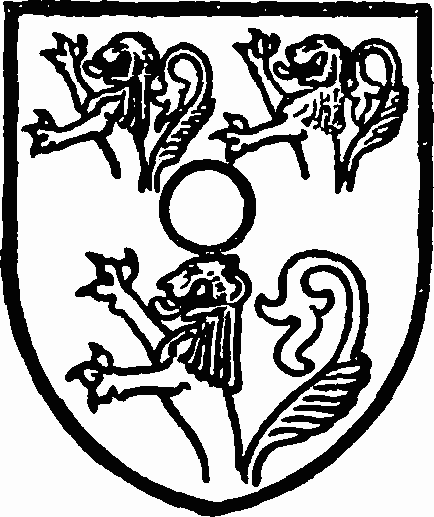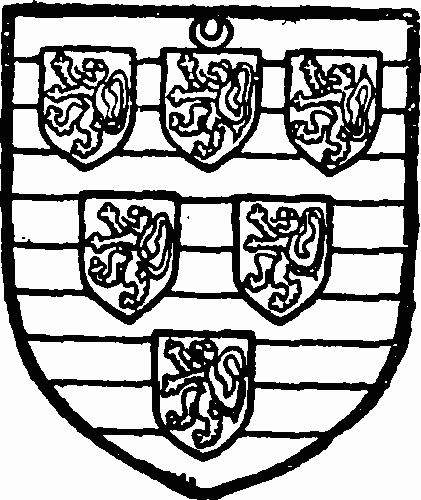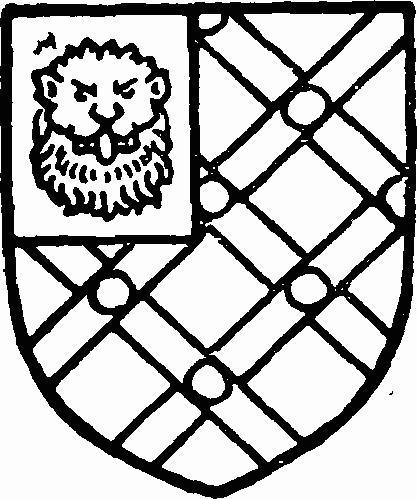A History of the County of Buckingham: Volume 4. Originally published by Victoria County History, London, 1927.
This free content was digitised by double rekeying. All rights reserved.
'Parishes : Calverton', in A History of the County of Buckingham: Volume 4, (London, 1927) pp. 308-311. British History Online https://www.british-history.ac.uk/vch/bucks/vol4/pp308-311 [accessed 12 April 2024]
In this section
CALVERTON
Calvretone (xi cent.); Calverton or Calveston cum Stony Stratford (xvii cent.).
This parish lies south of Watling Street with a tributary of the Ouse as its western boundary. It has an area of about 1,981 acres, of which the greater part is laid down in grass. (fn. 1) The principal crops grown are wheat, oats, beans and barley. The land rises from about 200 to 250 ft. above the ordnance datum in the north and west to nearly 350 ft. in the south and east, the soil being light and stiff clay with a subsoil of clay and stone. The parish formerly included the west side of Stony Stratford, and the Inclosure Act passed in 1782 for Calverton covered this larger area. (fn. 2) Later, however, the west side of Stony Stratford was made a separate parish by Act of Parliament. The close connexion between these two places, and the fact that the manorial rights over the west side were held with those of Calverton, led to the manor of Calverton being often called the manor of Calverton with Stony Stratford, and the fair and market of Stony Stratford were included among its appurtenances. A further portion of this parish, a detached part called Stratford Bridge Meadows, was amalgamated with Stratford St. Giles by a Local Government Order dated 25 March 1883. Calverton End, the north part of the parish, is now a suburb of the town of Stony Stratford, and has some good villa residences, as well as the cemetery formed in 1856 at the expense of the parishioners of Stony Stratford. Here are also the water tower and pumping station of Stony Stratford waterworks, lying south of Horsefair Green, which occupies the extreme north-eastern angle of Calverton, this part of the parish being known as Calverton St. Mary.
The village lies on the Calverton road, a continuation of Silver Street in Stony Stratford. At its northern end are All Saints Church and the Manor Farm, formerly the manor-house, an interesting old building of stone. (fn. 3) It is of two stories with attics and a tiled roof, and the plan is of the L type, the main block being placed north and south with the entrance front on the west, and a wing at the north-east. The house, it would seem, was originally built during the tenure of the manor by the Earls of Oxford, about 1500, to which date a stone-mullioned two-light window on the ground floor of the west front may be assigned. Probably when the manor came to Henry Earl of Northumberland and Katherine his wife, at the end of the 16th century, an addition was made to the north-east wing, in the south front of which are two windows of three lights, now blocked, with stone mullions of this date. In 1659 Simon Bennett made considerable alterations to the house. He lengthened the original block southwards, built the attic with its dormer windows, and added the twostoried porch on the west front, which bears in a panel over the entrance this date and his initials, and on either side shields of arms now indecipherable. Alterations were also made to the 16th-century addition about this time. After the sale to William Selby Lowndes, at the beginning of the 19th century, further alterations were made and new windows were added. Inside the house is some good 16th and 17thcentury panelling with other fittings of the same periods.
The house is surrounded by a high stone wall inclosing several acres, probably 'the large orchard enclosed with a stately wall' referred to in the lawsuit of 1686 (see under manor (fn. 4) ). Local tradition places the scene of the murder of Mrs. Grace Bennett in the servants' hall, and the spot at which the murderer climbed over the wall and escaped into Gib Lane, an ancient pack-horse track at the back of the house, was said to be shown by a stone in the wall bearing the date 1693. (fn. 5)
South of the church are the school, built in 1857, and the almshouses, all east of the Calverton road. To the west of the church and of the road is the site of a Roman camp, (fn. 6) upon which the present rectory was erected in 1820 by Charles George Lord Arden, then patron. (fn. 7)
In addition to Calverton End there are the districts of Lower Weald, which lies south of the village, Middle Weald, south-east of Lower Weald, and Upper Weald, further south-east still. At each of these hamlets there are some 17th-century stone houses or cottages with thatched roofs.
Among place-names have been found Hadley on Culvercroft, Weedeford, Blaken field, Street field, (fn. 8) Parsonage Piece, Swans Nest Piece, Round Neale, Pot Yards Piece, the Hop Yards, Crosshill Close, Park Piece, (fn. 9) Pochers Piece, Botts Piece (fn. 10) (xvii cent.).
Manor
In the reign of Edward the Confessor CALVERTON was held by Bisi, a thegn of the king, and in 1086 it was assessed at 10 hides among the lands of Hugh de Bolebec. (fn. 11) His possessions, including this manor, afterwards formed the barony of Bolebec, held of the king in chief, (fn. 12) and Calverton was described as still so held as late as 1631. (fn. 13)
With the exception of a few temporary divergences, (fn. 14) Calverton followed the descent of Whitchurch (q.v.) until the death without issue of John Earl of Oxford in 1506. (fn. 15) Whitchurch passed with the title, but an Act of Parliament dated 13 March 1531–2 decreed that Ann widow of the late earl should enjoy Calverton Manor for life with remainder to Sir John Nevill, fourth Lord Latimer, the son of the earl's late sister Dorothy (who had died about 1526 (fn. 16) ) and of her husband John Nevill, third Lord Latimer; to the earl's second sister Elizabeth wife of Sir Anthony Wingfield; and to his third sister Ursula wife of Sir Edmund Knightley, serjeant-at-law, and their heirs. (fn. 17) Lord Latimer obtained the reversion of a third of the manor in 1541, (fn. 18) and with the other co-heirs entered into possession on the death in the spring of 1558–9 of Ann Countess of Oxford. (fn. 19)
Lady Ursula Knightley died without issue in the following year, and her share reverted to her nephews Lord Latimer and Sir Robert Wingfield. (fn. 20) On 1 January 1561–2 Sir Robert Wingfield received licence to alienate his moiety to John Wingfield and others, (fn. 21) to whom it was conveyed at the following Easter by him, (fn. 22) and he was dealing with it again in 1576, when with his wife Bridget he conveyed it to Richard and Anthony Wingfield. (fn. 23) His cousin Lord Latimer died in the following year, (fn. 24) and in 1580 a partition of property among his four daughters and co-heirs and Sir Robert Wingfield assigned Calverton Manor to Katherine the eldest daughter and Henry Earl of Northumberland her husband. (fn. 25) This partition was confirmed by Act of Parliament shortly afterwards. (fn. 26) The Countess of Northumberland, when a widow, conveyed the manor in 1586, as the manor of Calverton cum Stony Stratford, to Francis Fytton, (fn. 27) whom she afterwards married. (fn. 28) In 1592 she settled it on her son Sir Charles Percy for life, (fn. 29) and died on 28 October 1596. (fn. 30) Her eldest son Henry Earl of Northumberland was holding Calverton in 1615, (fn. 31) and in the following year he, with Sir Charles Percy, conveyed it to Sir Thomas Bennett, citizen and alderman of London. (fn. 32) Sir Thomas Bennett settled it in 1624 on his second son Simon Bennett of Beachampton, bequeathing by will the remainder to his third son Richard, and died at London in February 1626–7. (fn. 33) Richard died in the following April, and his brother, then Sir Simon Bennett, bart., died without issue on 20 August 1631, when he was succeeded by Richard's son Simon, (fn. 34) who made a settlement of the manor in 1649. (fn. 35) He appears to have been a Roundhead, as in 1660 he made a declaration 'of his laying hold of the King's gracious pardon as granted at Breda, and promise of future obedience.' (fn. 36) The death of Simon Bennett on 30 August 1682 is referred to by Luttrell in these words: 'The great Mr. Bennet of Buckinghamshire is . . . dead, and is said to have left a most prodigious estate behind him.' (fn. 37) His widow Grace Bennett continued his policy of inclosing arable land in the common fields and converting it into pasture ground, and was defendant in lawsuits to recover tithes therefrom in 1686 (fn. 38) and 1692. (fn. 39)
The depositions taken in the course of the later suit show the number of 'plow lands' of about 60 acres each that she kept 'in her owne hands laid downe and untilled so that the parish is almost depopulated and the fields looke like a wildernesse little being mowed and that which was generally so late and kept so long till it was spoyled.' On her own showing her management of the estate was not very fortunate, as she declared that 'shee lost £10,000 by her management of the Lordshipp of Calverton.' (fn. 40) She is described as 'a miserable, covetons and wretched person,' who 'living by herself in the House at Calverton, and being supposed to have great Store of Money by her, tempted a Butcher of Stony Stratford to get artfully into the House, and as there was no Body to assist her or call for Help he barbarously murthered her' (fn. 41) on 19 September 1694. (fn. 42) She left two daughters, co-heirs of their father, of whom Grace, the elder, married John Bennett of Abington, Cambridgeshire, (fn. 43) and Frances, the younger, James Earl of Salisbury. (fn. 44) Frances's son, James Earl of Salisbury, was dealing with the manor alone in 1714 (fn. 45) and in 1720 with Grace Bennett, then a widow. (fn. 46) By failure of issue of the elder sister, the sole interest in Calverton devolved on the Earl of Salisbury (fn. 47) and descended to his grandson James, (fn. 48) afterwards Marquess of Salisbury. He sold the manor in 1806 to William Selby Lowndes (fn. 49) of Whaddon (q.v.), whose great-grandson, Mr. William Selby Lowndes of Whaddon Hall, is the present owner.

Bennett. Gules a bezant between three demi-lions argent.

Cecil. Barry of ten pieces argent and azure six scutcheons sable each charged with a lion argent and a crescent for difference.

Lownedes. Argent fretty azure with bezants at the interlacings of the fret and a quarter gules charged with a leopard's head or.
Two hides in Calverton which had been held as a manor by a man of Queen Edith formed part of Hugh de Bolebec's holding in 1086. (fn. 50) They were afterwards subinfeudated by the Earls of Oxford, who retained overlordship rights over Calverton as late as 1632. (fn. 51)
Part of this estate was obtained by the Hintes family, and in 1227 Robert de Hintes held half a virgate in Calverton in right of his wife Sibyl. (fn. 52) A successor, Walter de Hintes, is returned as holding 1 hide in 1254. (fn. 53)
The remainder of this land was acquired by the Calverton family, a member of which, John de Calverton, had 1 virgate here in 1202, when he bestowed 6 acres of it on Calverton Church. (fn. 54) In the following year he acquired 'a cotland' from William son of Aluric (fn. 55) and later in the century accounted for one fee in Calverton. (fn. 56)
Another hide in Calverton was owned by the Templars, who were accused in 1254 of withholding the suit due. (fn. 57) It passed with their other possessions to the Knights Hospitallers, and was attached to their preceptory of Sandford (Oxfordshire). (fn. 58) A grant of these lands in fee was obtained in 1564 by Sir Francis Knollys and his wife Catherine, (fn. 59) a further grant being made in 1623 to his son William Viscount Wallingford and his wife Elizabeth. (fn. 60) They levied a fine of these lands in the following year, under the name of Calverton alias Stony Stratford Manor, (fn. 61) which appears to be identical with the second manor held by Sir Simon Bennett in 1631. (fn. 62) As there is no further trace of it, the two manors probably coalesced.
View of frankpledge was attached to the manor in 1254 (fn. 63) and free warren was claimed in 1275. (fn. 64) A fishery in the Ouse was among the appurtenances from the 14th to the 18th century. (fn. 65) There was a mill worth 13s. 4d. in 1086, (fn. 66) and there is mention of two in 1331 (fn. 67) and three in 1586. (fn. 68)
Church
The church of ALL SAINTS consists of a chancel, nave of three bays, south aisle, western tower and south porch. It was rebuilt in stone in the 12th and 14thcentury styles between 1818 and 1824, when some of the old details were re-used. The chancel arch and the nave arcade are apparently 14th-century work reset, and the two-centred tower arch over the modern semicircular arch may be of the 15th century rebuilt. All the fittings are modern.
There is a ring of six bells, all modern.
The plate consists of a chalice, paten, and flagon, probably of the 17th century, and a modern paten.
The registers begin in 1559.
Advowson
Richard the clerk of Calverton witnessed a deed with Robert de Whitfield, Sheriff of Oxfordshire 1182–5, (fn. 69) thus affording probably an early incidental reference to Calverton Church. (fn. 70) It was valued at £14 13s. 4d. in 1291 (fn. 71) and at £26 2s. 9d. in 1535. (fn. 72)
The advowson of the rectory was held in 1233 by Isabella Countess of Oxford, (fn. 73) and descended with the manor until the sale of the latter in 1806. (fn. 74) On or about this date (fn. 75) the advowson was alienated by the Marquess of Salisbury to Charles George Lord Arden, who presented in 1814, (fn. 76) and from whom it has descended to the present owner, the Earl of Egmont.
Lands in Calverton worth 12d. yearly were given for the maintenance of a light. (fn. 77)
Charities
The charity of Sir Simon Bennett, bart., for Calverton and other parishes, founded by will dated 15 August 1631, (fn. 78) is regulated by a scheme of the Charity Commissioners of 19 August 1902. The trust estate consists of the impropriate tithes of the manor of Bourton in the borough of Buckingham, amounting to £100 a year, and £400 Local Loans 3 per cent. stock, producing £12 a year, arising from accumulations of income. By the scheme the income, after deductions for land tax, is divisible into 181 parts, twenty-five of such parts, or about £12 a year, being applicable for the poor of Calverton; the like proportion for the poor of Beachampton, and ten other of such parts, or about £5 a year, for the church of Beachampton; forty other parts, or about £20 a year, for the poor of Buckingham; forty-one other parts for the poor of Stony Stratford, and the remaining forty parts for the repair of the highways in Calverton, Beachampton and Stony Stratford. The proportions for the poor are distributed in clothing.
Ambrose Bennett by his will dated 24 May 1630 gave 20s. yearly issuing out of the manor of Rotherhithe. (fn. 79) The annuity is usually applied in paying for the conveyance of poor people to the hospital and in providing boots.
The charity of Simon Bennett, or the Bradwell Estate Charity, was founded by his will, proved 1 February 1682–3, (fn. 80) whereby the testator bequeathed £100 for the poor of Calverton, £100 for the poor of the West Side of Stony Stratford, and £50 for the poor of Beachampton. The trust property now consists of 46 a. 1r. 31 p. of land at Bradwell, acquired at the inclosure of the parish in exchange for other lands originally purchased with the legacies in question, let at £46 10s. a year, and £300 consols, producing £7 10s. a year, held by the official trustees, who also hold a further sum of £502 7s. 5d. consols, which is being accumulated until 6 April 1929. The stock arises from the sale in 1902 of the Morning Star Inn, subject to a lease for sixty years from 6 April 1869 at a ground rent of £5 5s. In 1911 the share of Calverton amounted to £10 10s., of which 15s. was expended in work on the roads and the remainder in the distribution of coal.
An unknown donor's charity for apprenticing and for poor widows consists, of five cottages situate at Lower Weald, Calverton, comprised in a deed of 29 March 1739, and an allotment containing 7 a. or. 32 p., producing an annual income of £37 10s. In 1911 three premiums amounting to £18 were paid, and the sum of £9 was distributed among eighteen widows at Christmas.
